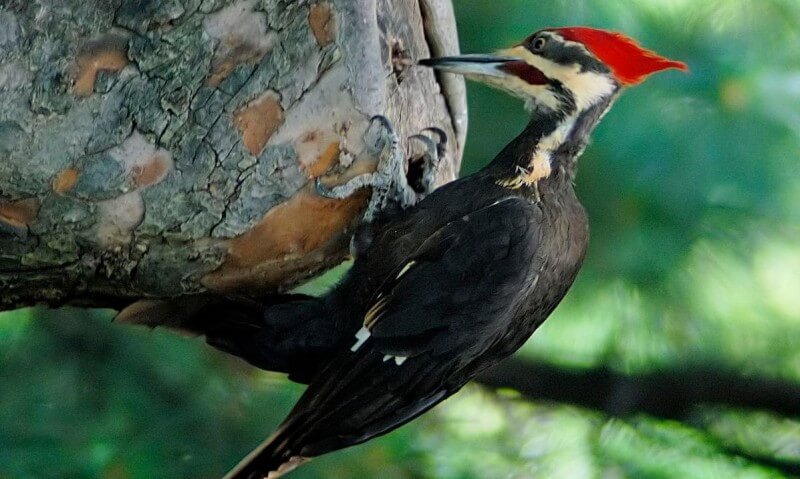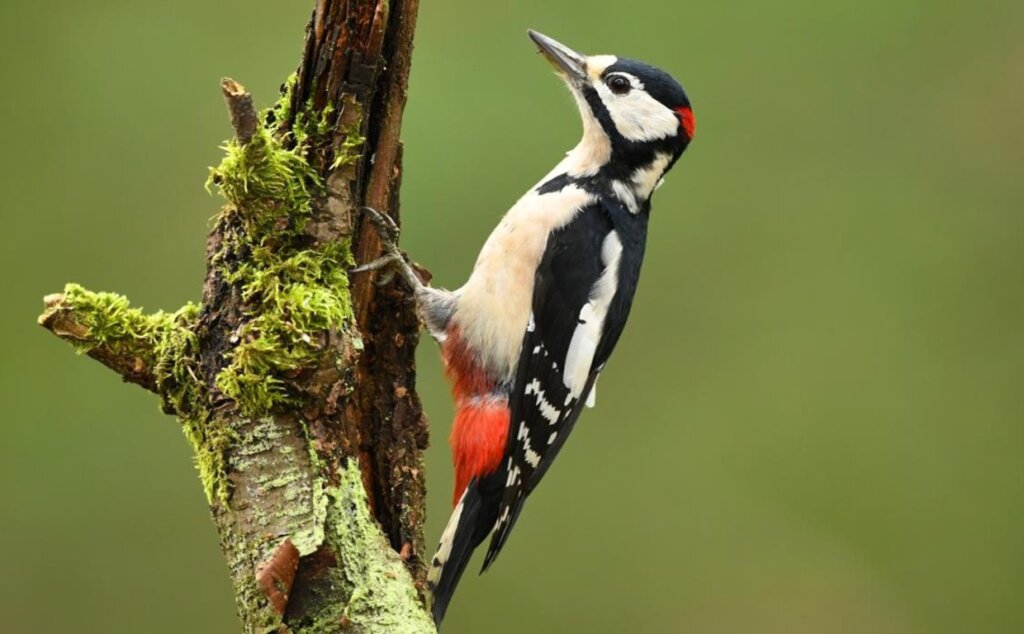5 Fun Facts About Woodpeckers

Woodpeckers belong to the family Picidae, a group of birds that includes some 300 species famous for drilling and drumming in trees. The average size of these specimens varies between 20 and 60 centimeters in length (8 – 24 inches). Likewise, they stand out for the strong and striking colors of their plumage.
Curious facts about woodpeckers
These birds are distributed almost all over the planet, and they have aroused the curiosity of several researchers over the years. And the fact is that this particular species isn’t only able to resist strong head movements when drilling, but has also developed a communication system that is completely different from that of most birds. Continue reading to get to know the most interesting aspects regarding these animals.
1. Exceptional skull design
Woodpeckers drill in trees for different reasons. It may be to drill out a nest, search for food, or to store it – they never stop drilling! This is why nature has given them certain special abilities to withstand this daily pounding. For example, one advantage that these birds have is that their brains are small compared to other species.
In more exact terms, their brain mass weighs only 2 milligrams, so the acceleration of their brains during the drilling is minimal. In addition to this, having its cranial cavity filled with cerebrospinal fluid reduces the risk of the brain moving in any direction.

On the other hand, by pecking at an angle and not directly, the force of the impact is lessened. Similarly, the structure of their skull is unique. On the one hand, the outer part is composed of hard bone, while the inner part is made of more porous tissue. Therefore, when pecking, the force exerted and received is distributed around the skull towards the more resistant bone, preventing intracranial injuries.
Finally, according to an article published in the journal Plos one, woodpeckers possess a bony and muscular structure called the hyoid apparatus, which helps to protect the brain from this impact.
2. Woodpeckers have a very long tongue
A woodpecker’s diet is based primarily on the consumption of insects such as termites, ants, or beetle larvae. These prey are obtained by pecking on the bark of trees and exposing them to the outdoors. However, its main hunting weapon is its tongue, which it uses as if it were an anteater.
This long organ can measure between 15 and 35 centimeters (6 to 14 inches), depending on the species of woodpecker. In addition, to prevent injury when drilling, the tongue is located behind the skull in a structure located in the nasal cavity.
3. They have a unique language among birds
Unlike songbirds, woodpeckers communicate by tapping on the wood of trees. Through these sounds, the birds can demarcate their territory, as well as call potential mating partners.
On the other hand, according to a paper shared in the scientific journal Scientific reports, woodpeckers are able to distinguish between the call of a known and unknown bird. Likewise, they can differentiate whether it’s a male or a female by the intensity of the tapping. According to the above, woodpeckers only use drumming as a source of communication among their own species.

4. Woodpeckers learn to drum
While some birds are born with the innate ability to sing, other species must learn it from their parents. This is the case of woodpeckers, whose learning process wasn’t clear until recently. However, an article published in the journal Plos one concluded that this species uses the same neural methods as songbirds to learn drumming.
What we mean here is that woodpeckers learn pecking patterns instead of melodies for singing. In addition, according to this research, these birds’ brains contain a gene called parvalbumin. This has also been found in songbirds and humans during the process of learning to vocalize.
5. The relationship between pecking and the ability to reproduce
Finally, according to an article in the journal Royal Society Open Science, there is a relationship between plumage coloration and the speed of drumming on trees. And, according to the findings of this research, the birds with stronger and more striking colors pecked at a higher speed. Such characteristics improve their chances of reproduction. Females tend to be more attracted to males that exhibit such distinctive features.
It is amazing how nature has given woodpeckers the ideal skills to prevent damage from hitting hard surfaces. Likewise, their whole nature is based on drumming, since, as we’ve seen above, they use it for feeding, reproduction, and communication with others of their species.
All cited sources were thoroughly reviewed by our team to ensure their quality, reliability, currency, and validity. The bibliography of this article was considered reliable and of academic or scientific accuracy.
- Cárdenas-Posada G, Fuxjager MJ. Correlated evolution between colour conspicuousness and drum speed in woodpeckers. 2022;9(10):221096.
- Schuppe ER, Cantin L, Chakraborty M, Biegler MT, Jarvis ER, Chen C-C, et al. Forebrain nuclei linked to woodpecker territorial drum displays mirror those that enable vocal learning in songbirds. PLOS Biology. 2022;20(9):e3001751.
- Wang L, Cheung JT-M, Pu F, Li D, Zhang M, Fan Y. Why Do Woodpeckers Resist Head Impact Injury: A Biomechanical Investigation. PLOS ONE. 2011;6(10):e26490.
- Węgrzyn E, Węgrzyn W, Leniowski K. Contact calls in woodpeckers are individually distinctive, show significant sex differences and enable mate recognition. Scientific reports. 2021;11(1):22769.
This text is provided for informational purposes only and does not replace consultation with a professional. If in doubt, consult your specialist.